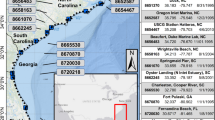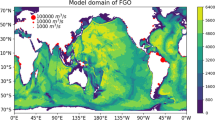Abstract
Cyclogenesis and long-fetched winds along the southeastern coast of South America may lead to floods in populated areas, as the Buenos Aires Province, with important economic and social impacts. A numerical model (SMARA) has already been implemented in the region to forecast storm surges. The propagation time of the surge in such extensive and shallow area allows the detection of anomalies based on observations from several hours up to the order of a day prior to the event. Here, we investigate the impact and potential benefit of storm surge level data assimilation into the SMARA model, with the objective of improving the forecast. In the experiments, the surface wind stress from an ensemble prediction system drives a storm surge model ensemble, based on the operational 2-D depth-averaged SMARA model. A 4-D Local Ensemble Transform Kalman Filter (4D-LETKF) initializes the ensemble in a 6-h cycle, assimilating the very few tide gauge observations available along the northern coast and satellite altimeter data. The sparse coverage of the altimeters is a challenge to data assimilation; however, the 4D-LETKF evolving covariance of the ensemble perturbations provides realistic cross-track analysis increments. Improvements on the forecast ensemble mean show the potential of an effective use of the sparse satellite altimeter and tidal gauges observations in the data assimilation prototype. Furthermore, the effects of the localization scale and of the observational errors of coastal altimetry and tidal gauges in the data assimilation approach are assessed.









Similar content being viewed by others
References
Altaf MU, Butler T, Mayo T, Luo X, Dawson C, Heemink AW, Hoteit I (2014) A comparison of ensemble Kalman filters for storm surge assimilation. Mon Weather Rev 142(8):2899–2914
Butler T, Altaf MU, Dawson C, Hoteit I, Luo X, Mayo T (2012) Data assimilation within the advanced circulation (ADCIRC) modeling framework for hurricane storm surge forecasting. Mon Weather Rev 140(7):2215–2231
Cañizares R, Heemink AW, Vested HJ (1998) Application of advanced data assimilation methods for the initialisation of storm surge models. J Hydraul Res 36(4):655–674
Cipollini P, Benveniste J, Bouffard J, Emery W, Fenoglio-Marc L, Gommenginger C, Griffin D, Høyer J, Kurapov A, Madsen K et al (2010) The role of altimetry in coastal observing systems. Proceedings of OceanObs 9
Etala P (2009a) Dynamic issues in the SE South America storm surge modeling. Nat Hazards 51:79–95
Etala P (2009b) On the accuracy of atmospheric forcing for extra-tropical storm surge prediction. Nat Hazards 51(1):49–61
Evensen G (1994) Sequential data assimilation with a nonlinear quasigeostrophic model using Monte Carlo methods to forecast error statistics. J Geophys Res 99(C5):10143–10162
Heemink AW, Kloosterhuis H (1990) Data assimilation for non-linear tidal models. Int J Numer Methods Fluids 11(8):1097– 1112
Hunt BR, Kostelich EJ, Szunyogh I (2007) Efficient data assimilation for spatiotemporal chaos: a local ensemble transform Kalman filter. Physica D: Nonlinear Phenomena 230(12):112–126
Kalnay E, Li H, Miyoshi T, Yang SC, Ballabrera-Poy J (2007) 4DVar or ensemble Kalman filter?. Tellus 59(5 09):758–773
Li Y, Peng S, Yan J, Xie L (2013) On improving storm surge forecasting using an adjoint optimal technique. Ocean Modelling 72:185–197
Lionello P, Sanna A, Elvini E, Mufato R (2006) A data assimilation procedure for operational prediction of storm surge in the northern Adriatic Sea. Cont Shelf Res 26(4):539–553
Miyoshi T, Yamane S (2007) Local ensemble transform Kalman filtering with an AGCM at a T159/L48 resolution. Mon Weather Rev 135(11):3841–3861
Naeije M, Schrama E, Scharroo R (2000) The Radar Altimeter Database System project RADS, Geoscience and Remote Sensing Symposium, IGARSS 2000, IEEE 2000, International, vol 2
Ott E, Hunt BR, Szunyogh I, Zimin AV, Kostelich EJ, Kostelich M, Corazza M, Sauer T, Kalnay E, Patil DJ, Yorke JA (2004) A local ensemble Kalman filter for atmospheric data assimilation. Tellus 56A:415–428
Peng SQ, Xie L (2006) Effect of determining initial conditions by four-dimensional variational data assimilation on storm surge forecasting. Ocean Model 14.1:1–18
Philippart M, Gebraad A, Scharroo R, Roest M, Vollebregt E, Jacobs A, van den Boogaard H, Peters H (1998) Data assimilation with altimetry techniques used in a tidal model, 2nd program. DATUM 2 Project NRSP-2 98-19. Tech. rep., Netherlands Remote Sensing Board (BCRS)
Saraceno M, D’Onofrio EE, Fiore ME, Grismeyer WH (2010) Tide model comparison over the Southwestern Atlantic Shelf. Cont Shelf Res 30(17):1865–1875
van Velzen N, Verlaan M (2007) COSTA a problem solving environment for data assimilation applied for hydrodynamical modelling. Meteorol Z 16(6):777–793
Verlaan M, Heemink AW (1997) Tidal flow forecasting using reduced rank square root filters. Stoch Hydrol Hydraul 11:349– 368
Verlaan M, Zijderveld A, de Vries H, Kroos J (2005) Operational storm surge forecasting in the netherlands: developments in the last decade. Phil Trans R Soc A: Math, Phys Eng Sci 363(1831):1441–1453
Wei M, Toth Z, Wobus R, Zhu Y (2008) Initial perturbations based on the ensemble transform (ET) technique in the NCEP global operational forecast system. Tellus 60A:62–79
Acknowledgments
We are thankful to E. Kalnay and J. Ruiz for their comments and discussions on this work. This work was partially supported under grant PIDDEF 046/10, Ministry of Defense. C. Romero and S.M. Alonso provided support to the validation. To the anonymous reviewers whose remarks contributed to improve the manuscript.
Author information
Authors and Affiliations
Corresponding author
Additional information
Responsible Editor: Kevin Horsburgh
This article is part of the Topical Collection on The 13th International Workshop on Wave Hindcasting and Forecasting in Banff, Alberta, Canada October 27 - November 1, 2013
Rights and permissions
About this article
Cite this article
Etala, P., Saraceno, M. & Echevarría, P. An investigation of ensemble-based assimilation of satellite altimetry and tide gauge data in storm surge prediction. Ocean Dynamics 65, 435–447 (2015). https://doi.org/10.1007/s10236-015-0808-z
Received:
Accepted:
Published:
Issue Date:
DOI: https://doi.org/10.1007/s10236-015-0808-z




